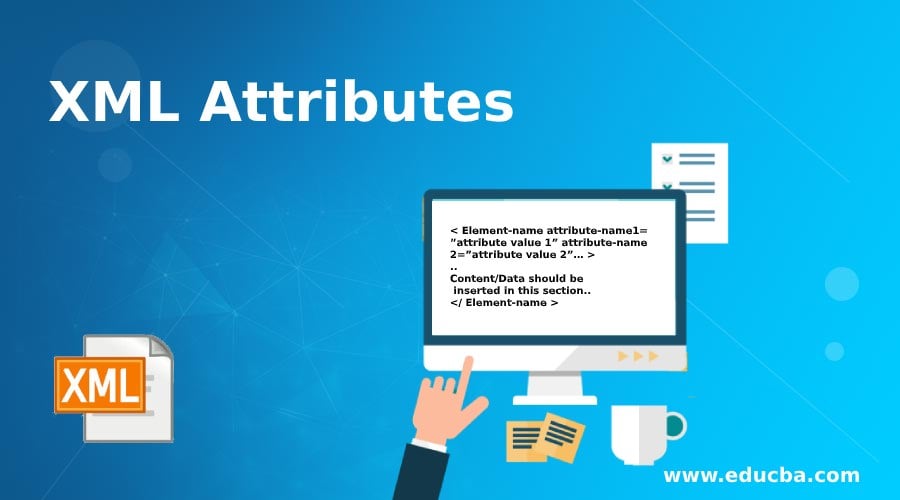Updated April 6, 2023
Introduction to XML Attributes
Attribute can be described as a property of any object. It defines the way any object in any language derives its behavior from. We can characterize or set these attributes as per business requirements and can apply them on XML script to modify the language behavior. XML tags come with a facility to have attribute syntax for the work.
We use attributes to be precise while defining any element. Using attributes, we can inject multiple functionalities into an application enriching its look and usage. It is a value addition to basic elements.
Syntax:
XML attributes have their specifications defines. We need to follow the syntax rules while attributing any object in XML. The syntax of defining attributes is described below:
< Element-name attribute-name1=”attribute value 1” attribute-name2=”attribute value 2”… >
..
Content/Data should be inserted in this section..
</ Element-name >
Example:
Let’s take a real-life example to explain the syntax.
<employee job_type=”full time”>
or
<employee job_type=’on contract’>
The attribute name should be followed by equals (=) along with a value assigned to it. The value of attribute should be captured under semicolons.
How does Attributes Work in XML?
Attributes should be defined under the element tag just the way described in the above section. These attributes tag an element with a special value. The value is then used to differentiate these element’s characteristics with the normal element without attributes assigned to it. We can have any number of attributes defined in XML. We just need to include these attributes in the element tag and utilize it. We can categorize attributes by attribute type:
- String Type: It takes a string as an input. Cdata is a string type.
- Tokenized Type: In such type of attributes XML grammar is applied to extract a normalized value. These are Id, Idref, Entity, Nmtokens, Entities, Nmtokens, Idrefs.
- Enumerated Type: Here we must choose a value for the attribute from the predefined list of allowed attribute values. These are NotationType, Enumeration.
Features of XML Attributes
Some features of attributes are listed below:
- These attributes are unique. That means attribute 1 will not be equal to attribute 2.
- One element can have many numbers of attributes.
- One attribute can be assigned to different elements simultaneously.
- The scope of the attribute is limited to the element to which it is assigned. Then the same attribute if used by other elements then its scope will be limited to another element. These two elements can behave in different ways as per the attribute values assigned.
- One element can be declared multiple times with different attributes in case we do not want to have multiple elements with different names. We want to keep only one element with different characteristics. In this case, the usage of attributes becomes vital for data to save and structured documentation by adding a bit more information for differentiation.
- An attribute name should not appear twice or more in the same or empty element tag.
- One attribute can not hold multiple values at the same time. For eg: < element attribute=”value 1 value 2 value 3…”> is not correct way of assigning values.
- Attributes should be declared already before using them under DTD (Document type definition). Generally, at the start of the XML document.
- Proper use of “<>” should be done. All the starting braces “<” should have closing braces “>” otherwise grammar rules will be revoked.
- We can also have the same attribute assigned to the same elements when these elements are declared as separate tags. By tag we mean an element encompassed under these braces “<element>”. This case is understood better by looking at the example described in the next section.
Example of XML Attributes
Below is the sample code snippet to demonstrate the usage of attributes in the XML language.
Code:
<?xml version = "1.0" encoding = "UTF-8"?>
<!DOCTYPE painting [
<!ELEMENT painting (Chart_paper)*>
<!ELEMENT Chart_paper (#PCDATA)>
<!ATTLIST Chart_paper category CDATA #REQUIRED>
]>
<Painting>
<Chart_paper category = "Hard paper" />
< Chart_paper category = "Scrap paper">
< Chart_paper category = "Tissue paper">
</plants>
</Painting>
Explanation: In the above code we have assigned an attribute named ” category” to an element named “Chart_paper”. This is an example where one element named “Chart_paper” is assigned to the same attribute “category” but with different attribute values. Here Chart_paper is divided into three categories described above. These attributes are defined at the start of the XML document under the DOCTYPE tag. This declaration is important if we are using the attributes further in the document.
Advantages and Disadvantages
Some of the advantages of using attributes along with elements are listed below:
- We can limit the usage of unnecessary element tags. Rather we can have an element with attributes for the same. Like in place of this:
<Employee>
<Gender> Female</Gender>
<Name>Meghna</Name>
<DOB>25-03-1994</DOB>
</Employee>
We can use:
<Employee gender="female">
<Name>Meghna</Name>
<DOB>25-03-1994</DOB>
</Employee>
- Simplifies data sharing by avoiding the use of various elements. Although there is not a difference in the way data is transmitted in the previous two code snippets. It’s just the scheme of arrangement of data.
- We can define data in a precise way thus improving the clarity of data definition.
- Since we can not assign multiple values to the sane attribute so it acts as a disadvantage and we need to declare the same element again with the same attribute just to store multiple values.
Conclusion
Attributes can be considered as “metadata” (Metadata is data about data). It facilitates the way any tag in XML should convey the output. We can have multiple attributes assigned to one XML Tag. We can parameterize the functionality of tags using XML attributes.
Recommended Articles
This is a guide to XML Attributes. Here we also discuss the Introduction and how do attributes work in xml along with advantages and disadvantages. You may also have a look at the following articles to learn more –



